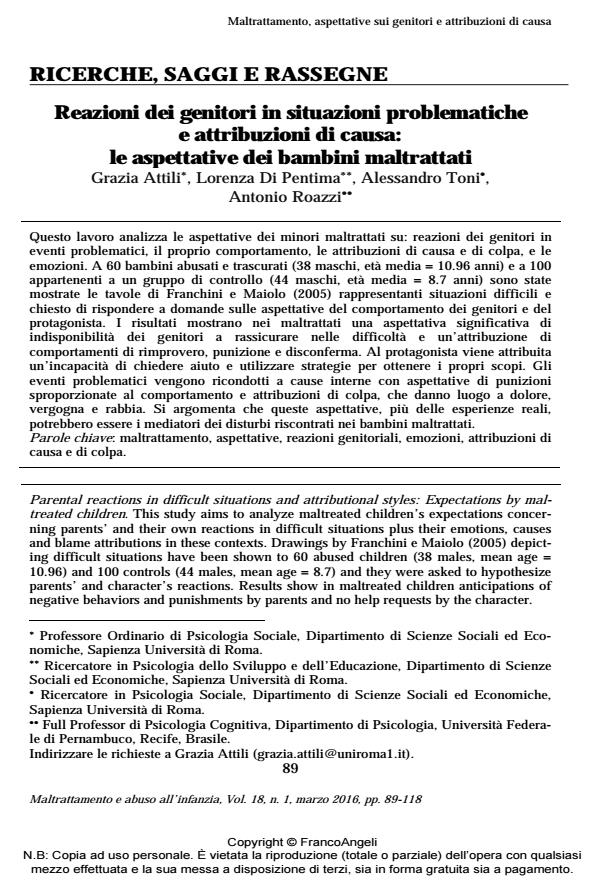Parental reactions in difficult situations and attributional styles: Expectations by maltreated children.
Journal title MALTRATTAMENTO E ABUSO ALL’INFANZIA
Author/s Grazia Attili, Lorenza Di Pentima, Alessandro Toni, Antonio Roazzi
Publishing Year 2016 Issue 2016/1
Language Italian Pages 30 P. 89-118 File size 166 KB
DOI 10.3280/MAL2016-001005
DOI is like a bar code for intellectual property: to have more infomation
click here
Below, you can see the article first page
If you want to buy this article in PDF format, you can do it, following the instructions to buy download credits

FrancoAngeli is member of Publishers International Linking Association, Inc (PILA), a not-for-profit association which run the CrossRef service enabling links to and from online scholarly content.
This study aims to analyze maltreated children’s expectations concerning parents’ and their own reactions in difficult situations plus their emotions, causes and blame attributions in these contexts. Drawings by Franchini e Maiolo (2005) depicting difficult situations have been shown to 60 abused children (38 males, mean age = 10.96) and 100 controls (44 males, mean age = 8.7) and they were asked to hypothesize parents’ and character’s reactions. Results show in maltreated children anticipations of negative behaviors and punishments by parents and no help requests by the character. Internal causes with expectations of punishments, self and parents’ blame, sorrow, anger and shame have been also found. It is argumented that these anticipations, more than real experiences, could mediate the disorders found in maltreated children.
Keywords: Maltreatment, expectations, parental reactions, emotions, cause and blame attributions
- Il paradosso del lockdown da COVID-19: cosa accade alle donne e ai minori nei contesti maltrattanti Lorenza Di Pentima, Alessandro Toni, in MALTRATTAMENTO E ABUSO ALL'INFANZIA 3/2021 pp.11
DOI: 10.3280/MAL2021-003002 - L'impatto della violenza assistita sui minori: attaccamento, locus of control ed esiti psicopatologici Lorenza Di Pentima, Alessandro Toni, Grazia Attili, in MALTRATTAMENTO E ABUSO ALL'INFANZIA 2/2021 pp.83
DOI: 10.3280/MAL2021-002006
Grazia Attili, Lorenza Di Pentima, Alessandro Toni, Antonio Roazzi, Reazioni dei genitori in situazioni problematiche e attribuzioni di causa: le aspettative dei bambini maltrattati in "MALTRATTAMENTO E ABUSO ALL’INFANZIA" 1/2016, pp 89-118, DOI: 10.3280/MAL2016-001005